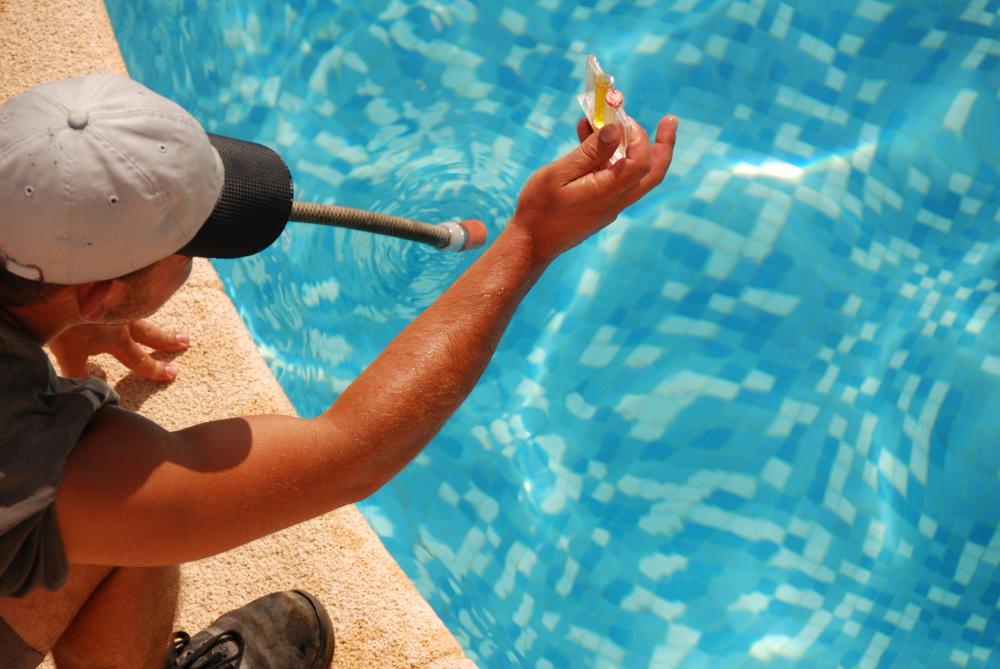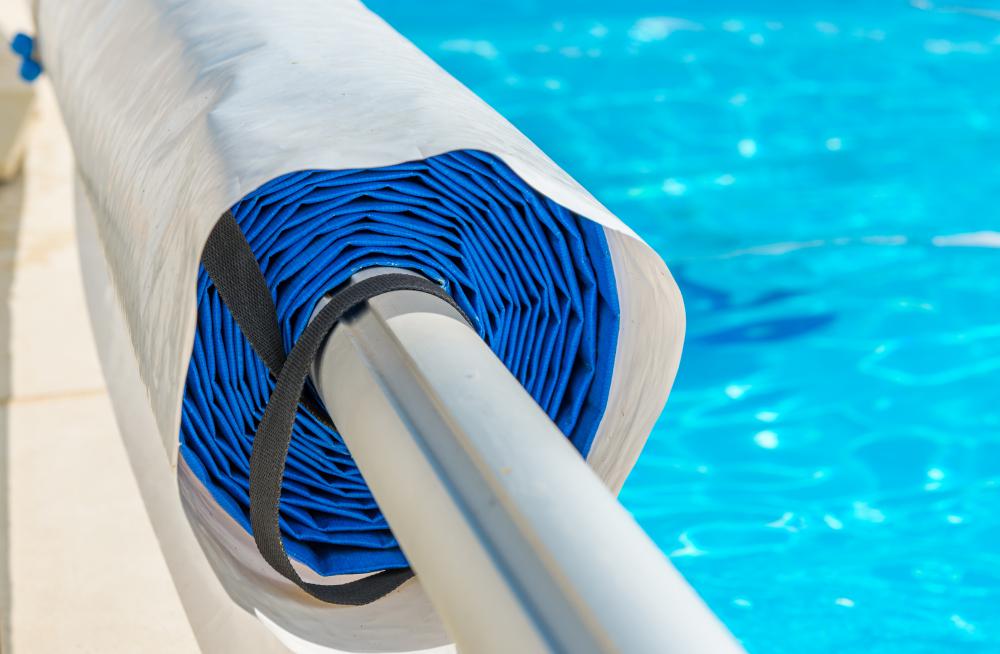At HomeQuestionsAnswered, we're committed to delivering accurate, trustworthy information. Our expert-authored content is rigorously fact-checked and sourced from credible authorities. Discover how we uphold the highest standards in providing you with reliable knowledge.
How do I Winterize a Swimming Pool?
To properly winterize a swimming pool, the owner should begin by making sure that the pool water is clean of debris. Leaves, bugs, pine needles and other similar items should be vacuumed or removed from the pool by use of the filter, or by using an extension pole and net to skim the water. A good time to begin the winterizing process is in the fall, just as the colors change, but before the leaves have a chance to fall into your pool.
A chemical treatment to your pool is essential. A mixture of winter chlorine, winter alkalizer, and winter powder will ensure that your pool stays clean over the winter and is ready for use in the late spring when the warmer weather arrives. Many manufacturers supply ready-made, winterizing kits that contain the chemicals mentioned above. Each manufacturer has different directions so make sure you follow the exact directions on your winterizing kit. Essentially, these chemicals will put extremely high levels of chlorine, alkaline, and algaecide in the water to prepare for the winter months ahead. Some of these chemicals mandate that the pool filter be turned on while the chemicals are added. Make certain you follow this direction. The failure to do so may result in stains to your liner.

Once the chemicals have been added, the pool water is ready for a slight draining to appropriate levels, if required by your pool manufacturer. Once the water is several inches below the level of the skimmer and output holes, you can cease draining and remove the filter hoses attached to the skimmer and output hole. If draining is not required, then cover the filter skimmer and output hole with the appropriate covers. This cover will prevent water from leaking and ice from forcing its way out. With the covers in place, remove the filter hoses. Open the drain at the bottom of the filter to let any water in the filter outlet. Store the filter and hoses in a garage or basement for the duration of the winter. Leaving a filter outside over the winter will lead to serious damage, especially if you fail to drain the filter.

The last item needed for a proper winterizing is a pool cover. However, before stretching the cover across the pool, you should install a floatation device in the center of the pool. This device can be a car or truck inner-tube or a large inflatable winter pillow sold by pool suppliers for this very purpose. The float serves two functions. First, it balances the rainwater and ice sure to form on your pool's cover over the winter. Secondly, The area around the float will not freeze over the winter and will allow the ice to push inward toward the float, rather than outward towards the pool wall. This will ease the tension on the pool walls, a condition that can lead to support problems later.

Finally, stretch the cover across the pool and over the float using two or three others for help. Once the cover is in place, you should run a sturdy wire through the holes that run along the outer seam of the cover. Pull the wire tight using a hand wench or similar tool so that the cover fits snugly around the pool. Failure to properly secure the cover will result in the pool cover coming off during high winds or heavy rains. Your pool is now ready to battle the winter elements, and will be ready for a sparkling clean opening come spring.
AS FEATURED ON:
AS FEATURED ON:













Discussion Comments
I have an intex-A 18 x 48 above ground pool with a round metal frame with poles. I had to dig down three inches on one side. Do I use dirt to fill it in or what?
At what temperature should I cover my pool? I have heard if you wait until the water temp lowers to a certain degree, algae won't grow over the winter months.
What is the best pool cover to use to make sure that everything will be fine and will work well? What kind of material should I pick to have the best result?
Why does the water level drop over winter, despite an excellent cover which includes a strip down the middle that allows rain water to enter the pool through a fine filter?
I've just had a look and the water level has dropped about 10 inches!
I cannot understand how or why.
Could there be a leak?
We closed our pool in 2008 and did not open it this summer. Do we have to add any new/more chemicals this year for the winter? We live in Delaware (USA). it is an in-ground pool with a mesh safety cover.
I lower the water below the skimmer and outlet hoses on my above ground pool and use no cover.
I also live in Minnesota. I drop the water level below the skimmer and outlet hole by about 6". I find that by spring with the snow fall and/or rain water, the level increases to at or above the skimmer/outlet hose.
Secondly, for the first few years I used a cover on my above ground pool. I had an awful experience for the first three or four springs with the cover. I had difficulty getting the cover off and had much of the junk fall into the pool. I have had algae problems and geese waste falling into the pool. It was a terrible mess and took days and much chemicals to get back to normal.
I tried one winter without a pool cover and had very nominal problems in the spring. The water was clear. I had some leaves and the typical dust/dirt on the bottom and some neighbor kids throwing rocks in the pool. After a partial day of cleaning and added chemicals, I was swimming without the week delay as before.
what kind of air compressor should we buy to blow out the lines of our inground pool? this will be our first time closing ourselves..
none of the pool closing procedures on line mention pool antifreeze for the lines. i live in minnesota. why is this not mentioned?
I use a regular size shop vac to blow out my lines. Works well and never had a problem.
I live in a warm area in Murcia, Spain where the lowest winter temperature is 8 degrees C. To winterize this pool can I just add your prepared winterizing solution and leave for 5 or 6 months without lowering the water level?
If so do i need to leave the filtration on at a minimum setting?
hi, I'd like to know what setting I need to use on a multiport filter head and can I hook the vac to the discharge or wastewater pipe? Or how do I do this?
I want to close my inground swimming pool myself this year. I know what drain plugs to take out for the pump and what chemicals to add. I would like some information on how to blow out the lines from the skimmers to the pump. Thanks, John
Can I use a solar cover when winterizing?
We had an above ground pool installed late this summer. The water is still green and we've added everything we're supposed to, as far as chemicals are concerned. Will it hurt if we close the pool when it isn't crystal clear? The leaves are starting to take over!
Pool Closing
Inground pool:
1 return and 1 suction line both nearest to the pump and filter.
1 skimmer and 1 return line furthest from the pump and filter.
No main drain. The 1 return and suction line too low in the pool to drain by gravity.
Going to use an air compressor preset to 40 psi to avoid damaging water lines.
4 questions:
• Is 40 psi enough pressure to clear the lines?
• Which lines do I clear first, returns or suction?
• Where is the best location to attach compressor to clear lines?
-remove drain plug on chlorinator?
-remove pressure gauge on filter?
-remove drain plug on pump?
I live in northern minnesota temp drop to -30 with an above ground metal pool. If I drop the water level below the skimmer and outlet hoses can I still keep most of the water in the pool?
Post your comments